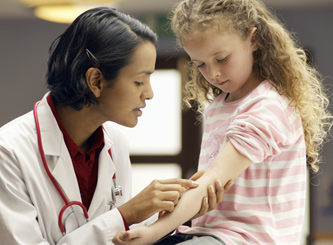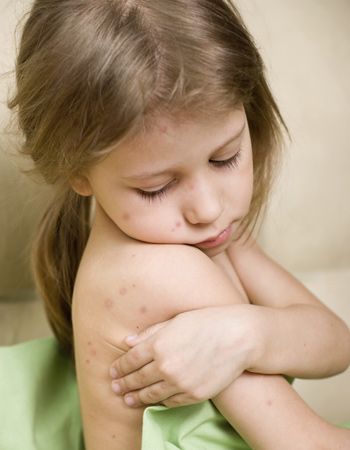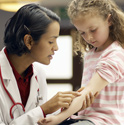Molluscum Skin Disease
Molluscum isn’t dangerous, but it’s inconvenient for parents.
“A pox upon your house!” cried a dying Mercutio in Romeo and Juliet. ( I know it’s actually “a plague upon your house” but somewhere along the line we started saying “pox.”)
The highly contagious nature of pox viruses has been known for centuries. Smallpox ranks as one of the most formidable killers in history. And other pox viruses, like monkeypox and chickenpox, are no laughing matter despite their humorous names.

But an overlooked little brother in the pox family is alive and thriving among us today: Molluscum contagiosum.
It’s scary to hear your child has a disease with the name contagiosum in it. Isn’t leprosy contagious? Plague? What about that HIV stuff going around? But for as unnerving as molluscum contagiosum’s name is, it is about the most harmless thing to catch. In fact it is considered one of the normal childhood skin rashes; right up there with ringworm and warts. Think of it like the common cold for the skin.
However this infection can have a real financial toll if you are a working parent dependent upon a daycare accepting your child. Many doctors are taught that it will clear up on its own and to not treat it. I still hear this point of view from otherwise very caring physicians. I’ve never understood this point of view. Molluscum is very contagious and has significant social and financial implications for families. And if you have been training for any kind of contact sporting event, this infection will have you sitting on the sidelines. And although simply covering the bumps to prevent contacting others is enough to prevent spreading it, most daycare centers and coaches simply do not want to incur the hassle or liability.
Molluscum Symptoms
Molluscum can appear anywhere on the body. These tiny bumps often look waxy and have a small dimple in their center. Often some inflammation will surround the growth and it can be mistaken for a variety of infections like chickenpox or impetigo. Molluscum sits atop the skin so shallowly that the waxy little balls you can see in it are actually nests of viral particles. It cannot venture into the blood or spread throughout the body. And unlike herpes or genital warts, once the bumps have resolved, you don’t harbor the virus anymore.
Parents wonder “How did this happen to my child?” and “Is there something wrong with his/her immune system?” Chances are there is nothing wrong with the little one and the skin’s immune system will figure it out sooner or later. Molluscum is so common in children that not a day goes by without seeing it in the office. When molluscum starts appearing in adults, it is time to consider that individual may have a dysfunctional immune system.

Molluscum Treatment
There are many ways to treat molluscum. The goal of any treatment is complete resolution without leaving a scar. Unlike common warts, molluscum usually resolves after a single session. By far the most common modality for treating them is applying liquid nitrogen to each spot. It works well but applying a substance that is -195 degrees to a child’s skin is no fun for the parent, the child or my ear drums. Some doctors will gently scrape them off with a special instrument or prescribe various creams (that are not insignificant in cost). There are some colloidal silver solutions that work well also for simple cases.
My favorite treatment is the application of a little blister beetle juice. It is painless at the time of application so the child does not come to associate coming to the office with torture. The chemical produces a small blister in the area later in the day that kills the infection.
This is not an FDA-approved treatment but has been used successfully by mainstream dermatologists for several decades. Even ancient China and Greece reportedly knew of its medicinal value. In fact it works so well, we are waiting on the government to ban its use since it cannot be manufactured in this country (watch the price skyrocket if it ever is). It is such a deceptively simple treatment and seems out-of-time in our age of lasers and gadgets. Squash a bug and smear it on your skin — how vulgar! Visiting one of these factories where it is produced is on my bucket list before I die. I always wonder how the compound is collected. Do they grind up thousands of bugs? Collect it like honey? The blister beetle is better known in pop culture as the Spanish Fly. It has mythical properties as an aphrodisiac that even my ultraconservative grandmother knew about (although not firsthand I’m sure). Historical rumor says it was slipped into King Louis XIV’s food to increase his desire for Madame de Montespan; and even Augustus Caesar’s wife plied guests with it hoping to liven up the party.
So, yes, those bumps on your child can likely be cured with a little Spanish Fly. Who knew such a simple skin infection could be so much fun!

